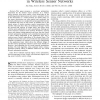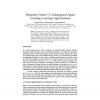116 search results - page 7 / 24 » Nonseparability of Shared Intentionality |
ICRA
2002
IEEE
14 years 9 days ago
2002
IEEE
Most physically implemented multi-robot controllers are based on extensions of behavior-based systems. While efficient, such techniques suffer from weak representational power. Sy...
ICRA
2006
IEEE
14 years 1 months ago
2006
IEEE
— Many application tasks require the cooperation of two or more robots. Humans are good at cooperation in shared workspaces, because they anticipate and adapt to the intentions a...
TCOM
2008
13 years 7 months ago
2008
This paper proposes a cross-layer optimization framework for the wireless sensor networks. In a wireless sensor network, each sensor makes a local observation of the underlying phy...
IAT
2009
IEEE
14 years 2 months ago
2009
IEEE
In this paper, we present a new approach, called SATIS (Semantically AnnotaTed Intentions for Services), relying on semantic web technologies and models, to assist collaboration a...
AIED
2007
Springer
14 years 1 months ago
2007
Springer
In a multi-user, real-time, and situation-based learning environment, the availability of enough and appropriate situations is crucial for success. In order to improve effectivenes...


